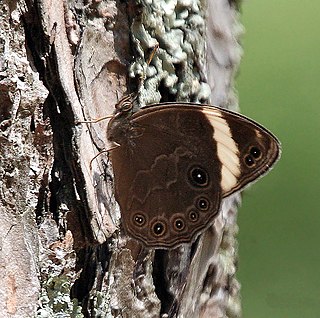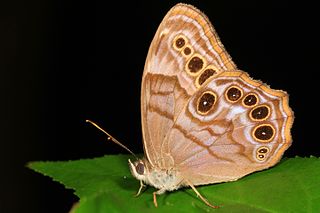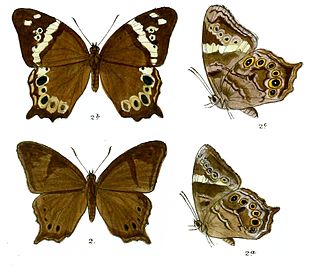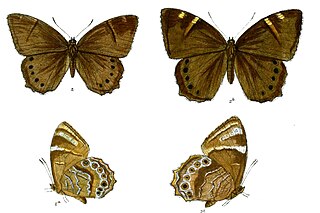
William Chapman Hewitson was a British naturalist. A wealthy collector, Hewitson was particularly devoted to Coleoptera (beetles) and Lepidoptera and, also, to birds' nests and eggs. His collection of butterflies, collected by him as well as purchased from travellers throughout the world, was one of the largest and most important of his time. He contributed to and published many works on entomology and ornithology and was an accomplished scientific illustrator.

Lethe is a butterfly genus from the subfamily Satyrinae in the family Nymphalidae. The genus was erected by Jacob Hübner in 1819. It includes the treebrowns, woodbrowns, foresters and their relatives. The species in the genus Lethe occur in temperate-tropical southern and eastern Asia, up to Indonesia and in North America.

The Satyrini is one of the tribes of the subfamily Satyrinae. It includes about 2200 species and is therefore the largest tribe in the subfamily which comprises 2500 species.

Heliconius comprises a colorful and widespread genus of brush-footed butterflies commonly known as the longwings or heliconians. This genus is distributed throughout the tropical and subtropical regions of the New World, from South America as far north as the southern United States. The larvae of these butterflies eat passion flower vines (Passifloraceae). Adults exhibit bright wing color patterns which signal their distastefulness to potential predators.

Callicore is a genus of nymphalid butterfly found in the Neotropical realm. This genus, like some related ones, was formerly lumped together as the paraphyletic Catagramma assemblage.

Simiskina is a genus of butterflies in the family Lycaenidae. The genus was erected by William Lucas Distant in 1886. The species of this genus are found in the Indomalayan realm.

Pronophilina is a Neotropical subtribe of butterflies of the subfamily Satyrinae. They are a species-rich group with highest diversity in the tropical and subtropical mountains, especially the Andes. Before 1970, they were poorly studied, but recent interest has resulted in high rates of species description from previously unexplored mountain ranges. However, there is still a lack of knowledge on their biology and ecology. Their relationship to other groups of Satyrine butterflies and their complex patterns of speciation within and among mountain ranges have led to several biogeographic discussions.

Lethe anthedon, the northern pearly-eye, is a species of butterfly of the subfamily Satyrinae in the family Nymphalidae. It is found in North America, from central Saskatchewan and eastern Nebraska east to Nova Scotia, south to central Alabama and Mississippi.

Lethe daretis, the Sri Lanka treebrown, is a butterfly in the family Nymphalidae. It is endemic and restricted to cloud forests of central highlands of Sri Lanka such as Horton Plains.

Lethe dynsate, the Ceylon forester, is a butterfly in the family Nymphalidae. It is endemic to Sri Lanka.

Lethe serbonis , the brown forester, is a species of Satyrinae butterfly found in the Indomalayan realm

Lethe latiaris , the pale forester, is a species of Satyrinae butterfly found in the Indomalayan realm

Lethe sidonis, the common woodbrown, is a species of Satyrinae butterfly found in the Indomalayan realm.

Lethe nicetas , the yellow woodbrown, is a species of Satyrinae butterfly found in the Indomalayan realm

Lethe atkinsonia, the small goldenfork, is a species of Satyrinae butterfly found in the Indomalayan realm.














